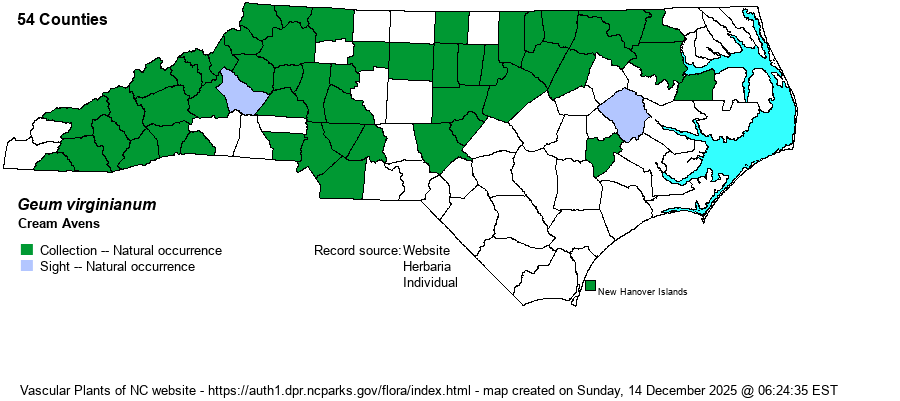| Author | L. | |
| Distribution | Throughout the Mountains, and essentially throughout the Piedmont; in the Coastal Plain limited to the northwestern portion, south to Washington and Lenoir counties, with a disjunct record for coastal New Hanover County.
This is an Eastern species, ranging from MA, NY, and MO south to SC and AR. | |
| Abundance | Declining, perhaps strongly. Formerly fairly common to frequent in the Mountains, and infrequent to locally fairly common in the Piedmont, but rare to uncommon in the northwestern Coastal Plain. Seems to have declined in recent decades, as it can be difficult to find in most of the state now. It is much less common than is G. canadense. | |
| Habitat | This is a species of rich to moist forests, especially on high pH soils. It grows in bottomlands, rich hardwood forests, and in more mesic sites it is found in clearly high pH soils of upland hardwoods. |
| Phenology | Blooms from June to August, and fruits from July to frost. As it blooms later than G. canadense, in the heat of midsummer, it is not easily found in bloom owing to many biologists reducing their time and effort at that season inside forests. | |
| Identification | This is a species reasonably similar to G. canadense, the one that biologists are more familiar; it grows to about 2 feet tall but it generally more stout. The stem is quite hairy. The basal leaves and stem leaves are somewhat larger than in G. canadense, but usually with fewer segments on the dissected leaves. The terminal leaflets are usually 3-lobed and much larger than all others. As with most in the genus, the leaves are reduced up the stem, and there is a branched inflorescence at the summit, with a single flower atop each branch. In this species, the 5 petals are creamy yellow to pale yellow, only about 1/8-inch long, and shorter than the sepals. Most of the flower consists of the green receptacle, and thus the pale yellow petals are barely visible at 10 or more feet away. Other Geum species have either white or bright yellow petals. Also, when in bloom, it can resemble several buttercup (Ranunculus) species, so be careful that you have the correct family and genus; Geum species tend to have very hispid stems and often hispid leaves, and basal leaves tend to be somewhat pinnately divided. This is a species that is normally seen just in leaf, and with others in the genus, take extreme caution when attempting to identify any just with vegetative characters. | |
| Taxonomic Comments | None
| |
| Other Common Name(s) | Pale Avens | |
| State Rank | S4 | |
| Global Rank | G5 | |
| State Status | | |
| US Status | | |
| USACE-agcp | FACW link |
| USACE-emp | FAC link |

